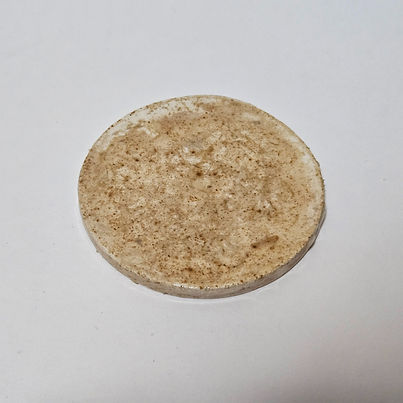Gupta Ananya

Fibra
Cement Juicer
We were required to use a combination of one primary material and one perishable food waste to create a new and innovative material. The goal was to look beyond conventions, and be as experimental as possible to produce unexpected yet interesting and feasible outcomes. The end outcome was a set of citrus fruit juicer, stainer and cup made by combining white cement and coconut fibre.
February 2024 - April 2024 | 8 weeks
Design Process
Ideation
Since my primary material was white cement, I took inspiration from a mortar and pestle set for my final idea (number 3). Both cement and mortar and pestle have signifcant historical backgrounds. Before humans had fire or sharpened flint, mortar and pestle were the first tools for preparing food. While cement has played a pivotal role in the development of civilization, particularly in construction and architecture. I wanted to use the historical significance of cement as a way to complement the final design.

Experiment Set 1: Pure Cement Swatches
These sample swatches acted as the “constant variable” for all the experiments. I was able to compare the characterise like colour, strength of the later experiments against these 2 swatches.

White Cement

Grey Cement
Experiment Set 2: White Cement + Fruit Peel Swatches
For this set of experiments, I wanted to know if it was possible to dye cement using food waste naturally. Since the end goal was to make a juicer, I thought of using orange peel. I hoped to dye the cement yellow or orange. To explore more, I also used dragon fruit skin. I hoped it would dye the cement a pink/red colour.
The first attempt of both experiments cracked. For the second attempt, I could feel that the structural integrity of the material was very weak. There were already cracks in the experiments after it was fully dried. Therefore, I sealed it with epoxy resin to strengthen it.

White Cement + Orange Peel

White Cement + Dragon Fruit Skin
Experiment Set 3: White Cement + Coconut Fibre
For this set of experiments, I took inspiration from the metal reinforcements added between the concrete during construction. I wanted to use coconut fibre as an alternative to create the reinforcement in cement.
The strength of the two swatches was quite high. I decided to seal the samples with epoxy resin to enhance its colour. During the process, I discovered the optimal cement to coconut fibre ratio is 3:2. Too little fibre reduces strength, while excess fibre causes crumbing due to insufficient binder (cement)

White Cement + Blended Coconut Choir

White Cement + Coconut Fibre
Experiment Set 4: Cement + Pistachio Shell Swatches
The idea was inspired by concrete. To make the concrete, one would usually add crushed stones, sand and cement in a ratio of 4:2:1. I wanted to experiment if it was possible to replace the crushed stone with food waste. My first thought was nuts shell. Since I had Pistachios at home, I decided to use its shells for this experiment.
White cement + pistachio shell was the strongest of the three experiments. However, the sides of the expierements slightly chipped when taking it out of the mould. The experiment with White + Grey Cement + Pistachio Shell was the weakest and it cracked while drying. I also realised that the abrasive/sharp surfaces of crushed pistachio could be helpful when juicing.
Why coconut husk?
Apart from appreciating the overall aesthetics of white cement mixed with coconut fibre, there were two primary reasons why I chose this as my selected food waste.
Firstly, cement and coconut fibre are among the oldest materials used in manufacturing. Given that my design was inspired by mortar and pestle, I found this combination intriguing to explore.
Secondly, this material proved to be the strongest among the three experiments. The high tensile strength of coconut fibres serves as reinforcement when mixed with cement akin to the steel reinforcements used in construction when working with concrete.

Final Model
 |  |  |  |  |  |
|---|---|---|---|---|---|
 |  |  |  |
Explore more in Prototyping & Visualization: Littoral or return to Main Menu


